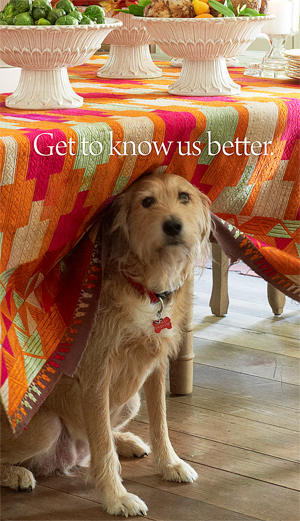The Story of a Brand

DURING THE MONTHS immediately following 9/11, I began as a freelancer to write catalog copy for a tiny startup called Wisteria. After thirty years in the business, I’d never come face to face with a brand quite like it.
Admittedly, the timing was coincidental. One event had nothing to do with the other, except in terms of a stark contrast I’ll attempt to describe.
It became a different world on September 11. One of my clients lost almost 300 employees in the north tower. Companies connected to aviation found themselves nearly as grounded as the planes. The entire advertising & design industry suffered deep setbacks. And for months afterward, it seemed those delicate sheets of white office paper that we saw drifting down from the World Trade Center represented cultural fallout that would continue to drift down on us forever.
Besides going into shock, many Americans went into a sort of mental retreat, as if they could hit reset and somehow make their way backward to some place untouched, some place that hadn’t been splashed with flaming jet fuel. Perhaps we were all looking for a simpler, safer place to ride out the pain. I found that place when I began writing for Wisteria.
Wisteria didn’t want what normally passes for catalog copy. The things they really wanted were more like stories. So I told a few. About the oddly comforting smell an electric furnace makes the first time it comes on in winter. Or what my dog might be dreaming about as he trotted sideways in his sleep on the floor. Or even how it felt to encounter both friendly and angry Muslims in Egypt. What other clients might reject as too personal, Wisteria considered perfect.
And not that I didn’t get to have fun writing about the products they had to sell, like for etched glass vases, “These etching techniques originated in the mid-1800s, when widespread joy over glass’s ability to transmit daylight and provide outward visibility gave way to the realization that the neighbors could now see you sitting in your bathtub.”
But in general I learned that what came to me instinctively, the writer’s impulse to tell a story, already had a home waiting at Wisteria. And when I joined the company as Creative Director several years later, I became part of a culture that grounded itself in what’s at the heart of every story, which is meaning.
As a company, we read A Whole New Mind, by Daniel Pink, about the current shift to a more right-brained, conceptual age; and The Advantage, by Patrick Lencioni, with its core principle that no company could long survive if it couldn’t offer a way to make the world a better place. We sought out overseas vendors who made a point of paying it forward in their own communities. And when we studied the fair trade network to see how we could be a part, we realized Wisteria had been doing a kind of fair trade long before fair trade became big business.
I finally left Wisteria earlier this year when it came time to return to the path I’d been on, but guess who I thought of first when I read Ty Montague’s article in the Harvard Business Review entitled, “Good Companies Are Storytellers. Great Companies Are Storydoers.”
The image above, showing Mary Jane’s dog Monkey peeking out from under a Wisteria table setting, is part of another story I got to tell, along with other examples elsewhere on this site. This post is itself a story, and since you’ve read this far, perhaps that’s additional evidence of the power stories seem to have over us. To learn more about that power, the books and article above are recommended reading, as is Wisteria itself, in that it is a story that continues to unfold.